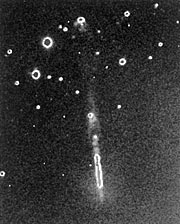Press Release
Witnessing the Violent Birth of a Solar-type Star
6 July 1989
Recent studies at the European Southern Observatory indicate that the formation of a new star is a dramatic process which may be more complex than most astronomers believed only a few years ago.
Earlier this year, observations with telescopes at the ESO La Silla observatory led to the discovery of an exceptionally interesting newborn star, situated within the confines of the giant interstellar cloud complex to which also the well-known Orion Nebula belongs. This particular object displays in a spectacular way the violent phenomena which accompany starbirth. We here witness a modern replay of energetic events which took place during the formation of our own solar system, approximately 4,700 million years ago.
The new observations were made by ESO astronomer Bo Reipurth. Searching for the signatures of newly born stars on wide-field photographs obtained with the ESO Schmidt telescope, he discovered a most unusual object in the constellation of Orion, near the celestial equator. A detailed analysis has shown that this object, now officially designated HH-111 [1] displays virtually all of the phenomena known to be associated with starbirth, in particular an intense stream of outflowing material (a "jet''), more prominently than in any other known object of this type [2].
Because of its great importance for our understanding of how stars are born, HH-111 will now be further investigated with all available observational methods.
Notes
[1] The designation means "Herbig-Haro type object no. 111''. The astronomers George Herbig (USA) and Guillermo Haro (Mexico) discovered the first objects of this class in the early 1950's, although the underlying astrophysical phenomena have only recently become more fully understood. On celestial photographs they are seen as small, bright nebulae, always in front of large interstellar clouds. The Herbig-Haro nebulae emit light mainly from excited hydrogen, nitrogen, oxygen and sulphur atoms.
[2] This Press Release is accompanied by a B/W photo showing the newly discovered HH-111 jet and also a contour plot of the entire system. A colour version of the B/W photo is available on request.
More information
A first analysis by Dr. Reipurth appears in an article in the July 6 issue of the scientific journal Nature.
Contacts
Richard West
ESO
Garching, Germany
Tel: +49 89 3200 6276
Email: information@eso.org
About the Release
| Release No.: | eso8906 |
| Legacy ID: | PR 04/89 |
| Name: | HH 111 |
| Type: | Milky Way : Nebula : Type : Jet |
| Facility: | Danish 1.54-metre telescope, ESO 1-metre Schmidt telescope |



